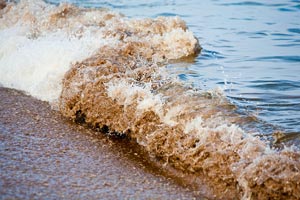A watchdog group is accusing the Obama administration of putting public relations ahead of scientific integrity in its communications about the Gulf oil spill. Last night, the Project on Government Oversight released emails sent between scientists and officials from the National Oceanic and Atmospheric Administration, the Environmental Protection Agency, the US Geological Survey, and the White House. POGO charges that emails show that the White House “may have ignored expert advice from agency officials and pressured scientists to make changes during the development of” an August report on the spill “in order to advance a public relations agenda.” POGO released the emails along with a letter to President Obama asking him to address concerns about scientific integrity.
In a separate letter to the White House this week, Rep. Raul Grijalva (D-Ariz.) raised concerns that even those emails released don’t tell the entire story of the oil budget. His office also requested records of communication on the oil spill budget. He notes in his letter to the president that the response his office received had “unjustifiable redactions,” “including entire pages blacked out in the middle of pertinent e-mail conversations.” Grijalva also raises concerns about transparency surrounding the oil spill budget.
But there is plenty to comb through in the emails. POGO points to an email in which Mark Miller, a scientist at NOAA, states that his office “received strong pushback” from the White House, which encouraged them to use an exact estimate of 4.9 million barrels of oil spilled into the Gulf, rather than a range of 3 to 5 million barrels that agency scientists had previously recommended. (POGO does note in its letter, however, that they believe the White House “deserves credit for erring on the side of the larger end of the spectrum of the possible size of the spill.”)
But POGO argues that hiding the uncertainty did a disservice to the public:
We are concerned that White House officials may have removed the uncertainty that typically comes with scientific measurements and settled on a more definitive number to make the public feel more comfortable. We feel that the public would be better served by understanding that the government’s handling of the Gulf spill is filled with numerous uncertainties.
In another email exchange the group released, EPA deputy administrator Bob Perciasepe expresses concerns about giving an exact percentage for the amount of oil that was chemically dispersed:
The percentages are very rough and should not be considered accurate. We still do not believe we should in a public document try to distinguish between naturally and chemically dispersed oil in the ocean. These calculations are extremely rough estimates yet when they are put into the press – which we want to happen – they will take on a life of their own. We should combine these two categories.
But Stephen E. Hammond, chief of the emergency operations office in US Geological Survey’s National Geospatial Program, brushed aside Perciasepe’s concern:
Based on how NOAA is developing a communication product with the [White House], the dispersion types (Natural & Chemical) will not be combined. We appreciate the case for combining them, however the goal is to show chemical dispersion as part of the Federal response to the spill.
The oil budget created some controversy after it was released on August 4, as some administration officials made inaccurate claims, stating that most of the oil was “gone” and that the report had been peer reviewed. There were also complaints that the agency NOAA had not released supporting documents for their initial report. A later, more thorough review of the report largely agreed with its findings, however.
Justin Kenney, NOAA director of communications and external affairs, released a statement to Mother Jones on the emails, indicating that they should be interpreted as demonstrating the “healthy scientific debate” that went on among agencies:
These documents reveal a commitment to share information with the public as soon as we were confident it was accurate, a close coordination among numerous agencies and the White House, and a healthy scientific debate that is the hallmark of good policy making, especially during a national crisis. Contents of these emails show the effort made to communicate real-time scientific information to the American public quickly and clearly. We were clear in our release, the report and at the press briefing how those numbers should be interpreted. In November, we released a peer-reviewed report, developed in collaboration with federal and independent scientists, that provides the technical documentation for the Oil Budget and largely validates the early results released on August 4.
The emails certainly show that there were internal debates among the agencies that may explain the unwillingness at NOAA to provide more detailed accounting of the oil in the Gulf at the time the budget was first released.
UPDATE: An EPA spokesman also responded to a request for comment about the allegation that the White House ignored their input on the report:
EPA was not directly involved in the creation of the oil budget, and many of the issues involved were outside EPA’s mandate. EPA officials and scientists were among many who participated in a robust conversation about specific technical and scientific issues. All good scientific discussions involve a robust back and forth among scientists, and that’s exactly what happened here.














